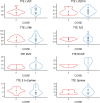Absence of long-term structural and functional cardiac abnormalities on multimodality imaging in a multi-ethnic group of COVID-19 survivors from the early stage of the pandemic
- PMID: 39045071
- PMCID: PMC11195772
- DOI: 10.1093/ehjimp/qyad034
Absence of long-term structural and functional cardiac abnormalities on multimodality imaging in a multi-ethnic group of COVID-19 survivors from the early stage of the pandemic
Abstract
Aims: Many patients with coronavirus disease-2019 (COVID-19), particularly from the pandemic's early phase, have been reported to have evidence of cardiac injury such as cardiac symptoms, troponinaemia, or imaging or ECG abnormalities during their acute course. Cardiac magnetic resonance (CMR) and transthoracic echocardiography (TTE) have been widely used to assess cardiac function and structure and characterize myocardial tissue during COVID-19 with report of numerous abnormalities. Overall, findings have varied, and long-term impact of COVID-19 on the heart needs further elucidation.
Methods and results: We performed TTE and 3 T CMR in survivors of the initial stage of the pandemic without pre-existing cardiac disease and matched controls at long-term follow-up a median of 308 days after initial infection. Study population consisted of 40 COVID-19 survivors (50% female, 28% Black, and 48% Hispanic) and 12 controls of similar age, sex, and race-ethnicity distribution; 35% had been hospitalized with 28% intubated. We found no difference in echocardiographic characteristics including measures of left and right ventricular structure and systolic function, valvular abnormalities, or diastolic function. Using CMR, we also found no differences in measures of left and right ventricular structure and function and additionally found no significant differences in parameters of tissue structure including T1, T2, extracellular volume mapping, and late gadolinium enhancement. With analysis stratified by patient hospitalization status as an indicator of COVID-19 severity, no differences were uncovered.
Conclusion: Multimodal imaging of a diverse cohort of COVID-19 survivors indicated no long-lasting damage or inflammation of the myocardium.
Keywords: COVID-19; cardiac inflammation; cardiac magnetic resonance; multimodality imaging; transthoracic echocardiography.
© The Author(s) 2023. Published by Oxford University Press on behalf of the European Society of Cardiology.
Figures




References
-
- Montero-Cabezas JM, Córdoba-Soriano JG, Díez-Delhoyo F, Abellán-Huerta J, Girgis H, Rama-Merchán JCet al. . Angiographic and clinical profile of patients with COVID-19 referred for coronary angiography during SARS-CoV-2 outbreak: results from a collaborative, European, multicenter registry. Angiology 2022;73:112–9. - PubMed
LinkOut - more resources
Full Text Sources
